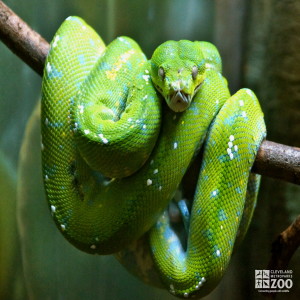Green Tree Python
[Morelia viridis]

The body of the Green Tree Python is laterally compressed with a large head that seems disproportionate to the width of the body. The tail is prehensile. They have greatly elongated foreteeth. The color of the adults is bright to dull emerald green above with a complete or broken series of white or yellow scales along the vertebral line and a few scattered white scales on the sides. A series of short, light blue bars extend out from the vertebral line. The belly is cream to light yellow. There are heat sensitive facial pits within the scales bordering the upper lip. The juveniles are a bright lemon-yellow, gold or orange to brick red, often with a dark purplish-brown white-centered streak through the eye and a vertebral stripe of the same color with short bars of brown extending from the vertebral line. Length can reach 6.5 feet, but rarely exceeds 1/2 that.
Location: The Lower RainForest
Share:
Range
The Green Tree Python's range is New Guinea and adjacent islands, Aru Island, Cape York Peninsula in Queensland, Australia.
Habitat
The habitat of the Green Tree Python is rainforest trees, bushes and shrubs.
Conservation Status
Least ConcernPrimary Threats
Gestation
Gestation is 54-56 days.
Litter
10-20 eggs, average is 15.
Behavior
Nocturnal and arboreal, Green Tree Pythons spend the day sheltered in tree hollows, epiphytic ferns and etc. Adults feed primarily on small birds either as they come in to roost or actively stalking them. They will sometimes be seen dangling from their strong prehensile tails while eating. They have a distinct and unusual resting posture. The coils are drawn into a series of folded loops neatly proportioned over a horizontal branch so that the head is always brought to rest in the center.
Reproduction
Green Tree Pythons are sexually mature at approximately 3 feet long. Eggs are laid on the ground with the female coiling around and incubating them. After the young are hatched they instinctively seek shelter in the trees. The color of the young will change to that of the adult by the time they are two years old, some as early as within a few weeks.
Wild Diet
Primarily birds, plus small mammals (including bats) and tree lizards. Juveniles often eat tree frogs.
Zoo Diet
Mice
